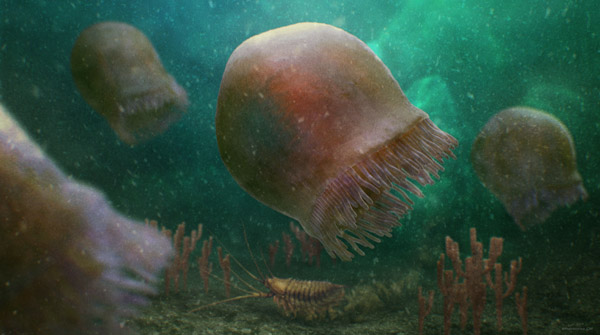Scientists at the Royal Ontario Museum (ROM) say they have found the oldest swimming jellyfish in the world, encased in rock for over 505 million years, in a study released Wednesday by The Royal Society Publishing.

The researchers who discovered this feat of time travel have dubbed it the Burgess Shale jellyfish, or Burgessomedusa phasmiformis, for the region in B.C.’s Yoho National Park where it was found. The Burgess Shale is an important fossil deposit because of its remarkable ability to preserve soft-tissue, which allowed these jellyfish to survive through epochs.
Jellyfish are thought to be “one of the earliest animal groups to have ever evolved,” according to study co-author Joe Moysiuk, a University of Toronto Ph.D. candidate. But jellyfish fossils are notoriously hard to find, given they are roughly composed of 95 per cent water.
This discovery leaves “no doubt” that jellyfish have been swimming around since the Cambrian period, Moysiuk said in a ROM news release, when an “explosion” of diverse species burst onto the evolutionary scene.
“Finding such incredibly delicate animals preserved in rock layers on top of these mountains is such a wonderous discovery,” said co-author, Dr. Jean-Bernard Caron, a ROM curator of invertebrate paleontology. “This adds yet another remarkable lineage of animals that the Burgess Shale has preserved chronicling the evolution of life on Earth.”
The ROM has about 200 specimens of Burgessomedusa phasmiformis in its archive, which were collected during the late 1980s and 1990s on a series of expeditions to the Burgess Shale.
“This is a study that has been in the works … for a long time,” Moysiuk told the Canadian Press.
After collecting dust on a shelf in the ROM for decades, Moysiuk said his lab mate, Justin Moon, who is lead author of the paper, decided to dig into their origin.
“This was part of his PhD research and I got to help him out,” he said.
The jellyfish fossils retain remarkable details about the species’ anatomy. The 500-million-year-old animal has that same familiar “blobby body with a series of tentacles” that you’d recognize in modern jellyfish, Moysiuk said.
The specimens were around 20 centimetres in length and had about 90 short, stubby tentacles. The researchers say the jellies would have been capable of free-swimming and its tentacles would have enabled them to capture sizeable prey.
These ancient jellyfish also share another interesting evolutionary feature with modern jellyfish, as Moysiuk explains.
“The jellyfish group has evolved this innovation where they undergo this two-part life cycle,” he said. “For the first part of their life, they look a little bit like an anemone sitting on the sea floor and then they undergo this metamorphosis and turn into the things that we commonly think of when we think of jellyfish.
“This discovery is showing us that this evolutionary innovation was already present half a billion years ago in the Cambrian,” Moysiuk told the Canadian Press.
The Burgess Shale fossil sites are located in the Rocky Mountains within Yoho and Kootenay National Parks, and are managed by Parks Canada. The region was designated a UNESCO World Heritage Site in 1980 and is world-renowned for its wealth of Cambrian fossils.








Comments